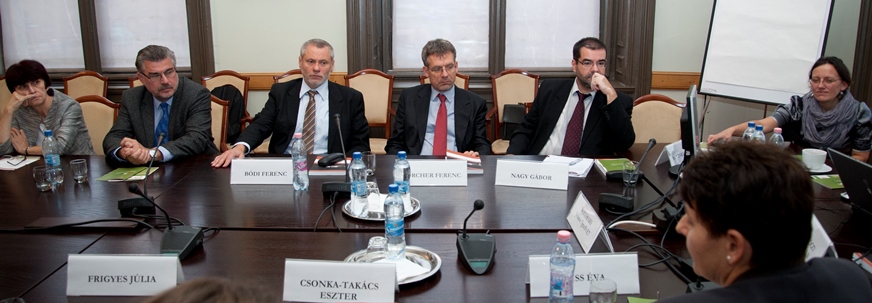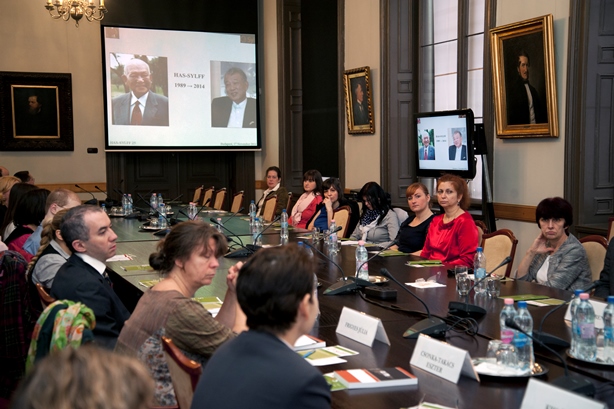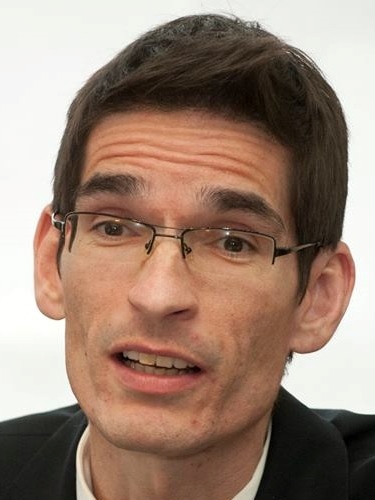Voices from the Sylff Community
May 14, 2015
Sylff’s Role in Hungary’s Democratization
Hungarian Academy of Sciences Celebrates 25 Years of the Fellowship Program
Viktoria Ferenc, Loretta Huszak, Balazs Csiky
The Hungarian Academy of Sciences received a Sylff endowment 25 years ago —the first Sylff endowment awarded to a Central European country — on November 9, 1989, the very day that the Berlin Wall fell. Three Hungarian Sylff fellows, reflecting on this historical fact, write about what the Sylff program has meant in Hungary and how it has nurtured leaders much needed by the country, which was then going through a dramatic process of democratization.
* * *

Participants of the meeting celebrating the twenty-fifth anniversary of the Sylff program in Hungary.
Historical Context
On May 20, 2009, Nippon Foundation Chairman Yohei Sasakawa, in his speech at the twentieth anniversary ceremony of the Sylff program at the Hungarian Academy of Sciences, placed the program in historical context:
“In 1989, Mr. Németh Miklós, then [minister] president of Hungary, helped tear down the Iron Curtain. In the same year, the Hungarian Academy of Sciences became the 16th Sylff School. Around that time, Central Europe was moving away from communism in the direction of the West. This move required leaders who could build new countries. It makes me very proud that this academy was the first in Central Europe to have a Sylff endowment to help nurture these leaders. . . . When the wall between East and West fell, things began to change. There was political reform in Hungary and other East European countries. A market economy was adopted. Civil society began to develop. The Nippon Foundation wanted to help Central Europe make these changes.”1
As Mr. Sasakawa summarized, 1989 was a year of miracles, a unique historical moment that transformed Europe and the world—and Hungary was in the center of the events. On August 19, 1989, civil groups organized a demonstration along the Austro-Hungarian border, the so-called Pan-European Picnic, where the border gate was symbolically opened for several hours. Hundreds of East German citizens used the opportunity to enter Austria.
One month later, on September 11, the Hungarian government officially opened the border for East German refugees. These were the first holes in the Iron Curtain, and as the West German Chancellor Helmut Kohl said on October 4, 1990, on the eve of German reunification, it was in Hungary where “the first stone was knocked out of the wall.”2
On November 9, 1989, the Berlin Wall fell, and on the same day Mr. Ryoichi Sasakawa signed the Agreement to found the first Central European Sylff institution in Hungary. This was the year when Hungary started its transition to democracy. A comprehensive amendment to the Hungarian Constitution took effect on October 23—on the anniversary of the 1956 Hungarian Revolution. This was also the birthday of the new Republic of Hungary.
According to the new preamble of the Constitution, the revision was needed “in order to promote the peaceful political transition into the rule of law realizing the multiparty system, parliamentary democracy and social market economy.”3 The transition from state socialism to democracy and capitalism would be a long process, requiring new approaches and young leaders.
Last year was a historic landmark for Central Europe. It marked the twenty-fifth anniversary of the biggest event in recent European history: the fall of the Berlin Wall on November 9, 1989. Germans recalled the “sheer madness” of the night in 1989, when thousands of East Berliners streamed across the border and thousands of helium-filled white balloons were lifted off one by one into the night sky to mark the wall’s fall. Last year’s Lichtgrenze was a light installation running through the city center that recreated this image.4
The Iron Curtain was a symbol of the suppression of fundamental rights in the Eastern bloc during the Cold War and represented a violent and ultimately ineffective episode in postwar history. Its downfall, and also the fall of the wall in Berlin, was emblematic of the end of the Cold War, setting the course for the reintegration of Eastern Europe into the Western economic, political, and security frameworks.
The commemoration of the collapse of the Iron Curtain is marked by a degree of poignancy because there is a palpable sense that peace in Europe is still fragile. In her speech at the wall memorial, German Chancellor Angela Merkel explicitly emphasized the geopolitical context of the twenty-fifth anniversary:
“We have the strength to shape things, to turn things from bad to good that is the message of the fall of the wall.”5
Similar sentiments were also expressed by Mr. Yohei Sasakawa in his message at Sylff’s twentieth anniversary in Hungary:
“Much has changed in the world since the program was first conceived. With the collapse of the Cold War structure, we have seen the emergence of a global society, one that is composed of many different value systems. Today’s world is a complicated place. It resembles a mosaic of disparate political, ethnic, cultural and religious viewpoints. It confronts us with many challenges, ranging from ethnic and religious conflicts to widening inequality. To find solutions to these problems, we need people who are committed to making the world a better place. Nurturing such people has been Sylff’s goal from the outset.”6
Consolidating Democratization
The endgame of communism in Hungary during the second half of the 1980s was more convoluted and confusing than in other East European countries. This was primarily because both the regime and the opposition were more visibly fragmented than in other East-bloc states—and the fragments were less synchronized with one another.7 Shedding the communist past has not been easy, moreover, as the legacy of almost half a century of communist rule was deeply embedded in the country’s political institutions and social structure. The radical transition entailed, in some cases, heavy costs, but it also opened up major new opportunities.
Social scientists and political actors are in agreement on the significance of the transformation that former communist countries have undergone since 1989–90. The transition from communism to capitalism is widely regarded as the complete substitution of one social system for another—a rare example of a wholesale system change.8 The consolidation of democracy included shaping public policy to promote independent governance, basic rights, and economic reforms. The necessity of achieving an effective economic, political, and social transformation simultaneously became known in the social sciences as the dilemma of simultaneity: “The only circumstance under which the market economy and democracy can be simultaneously implanted and prosper is the one in which both are forced upon a society from the outside and guaranteed by international relations of dependency and supervision for a long period of time. . . . Otherwise, there reigns everywhere an (at least) asymmetrical antagonism: the market requires the development of a democracy, but democracy does not demand the emergence of a market.”9
Thus, when the Hungarian Academy of Sciences signed the Agreement in 1989 to introduce the Ryoichi Sasakawa Young Leaders Fellowship Fund program, Hungary was in the midst of great political changes. Since the catalyst for the political transformation in Eastern Europe was the commitment of the elites to the creation of democratic institutions10, their role was crucial in fostering and consolidating democratization.11 Democracies require competitive elites who are committed to maintaining fair, transparent, and open-minded governance, and they were the ones primarily responsible for the political and economic transition in Eastern Europe. In this respect, the political and functional elites have played a decisive role in the multilayered process of societal transformation.12
This is true even today, 25 years later, as relatively young democratic institutions are still cultivating the requisite political culture and trying to achieve an optimum balance between political-administrative regulation and civil society.13 Transparency in Central and Eastern Europe remains an issue, and only a few professionals—mainly those active in the entrepreneurial sector of the economy—have attained the economic and social status typical in countries with a long history of parliamentary democracy. Others, mainly those working in the public sphere, are still hindered by the consequences of unequal opportunities. This makes the social cohesion and solidarity of the new middle strata rather fragile.14 As a consequence, the post-socialist political (and to some extent economic) elites are still fragmented or even divided.15
International support, however, always provides an impetus for democratization and plays an essential, irreplaceable role in safeguarding citizens’ legitimate rights and interests. In that sense, the signing of the Sylff Agreement in Central and East European states like Hungary undoubtedly had an impact on democratic consolidation in those countries. The benefits were not just financial; the spirit nurtured among the fellows definitely helped Hungary stay on track toward democratization.
One aim of the Hungarian representatives who helped prepare the Agreement was to support talented young students and send them to the international “arena” so they could spearhead the reintegration of Hungarian scholars in the humanities and social sciences into the international mainstream.16 Now, looking back over the preceding 25 years, we can definitely say that the fellowship recipients have become a determining factor in the formation of professional opinion in the country, and many of them have become leaders in their respective fields. As such, they have had great political and socioeconomic responsibility. Making democracy work requires a certain degree of political competence and commitment on the part of the nation’s citizens and, especially, leaders. Particularly in Eastern Europe, where the values nurtured during the communist era needed to be changed with the rules and norms of a capitalist, liberal democracy, education was an important means of achieving those changes.
Anniversary Gala and Brainstorming
On November 17, 2014, on the occasion of the twenty-fifth anniversary of the Sylff program at the Hungarian Academy of Sciences (HAS), a gala event was organized in Budapest entitled “Past, Present and Future: Gala and Brainstorming.” The event was officially part of the Festival of Science in Hungary 2014, a month-long series of events held under the theme of “Far-sighted Science.”
A visible sign of HAS’s support for the Sylff anniversary event was the presence of HAS President László Lovász. Takahiro Tanaka, second secretary at the Embassy of Japan in Hungary, was also among the prominent guests. Organizers also invited past and present fellows, members of the Sylff Steering Committee, tutors, and some young scholars who may become future applicants. Around 50 guests participated in the event to celebrate the anniversary.
After the welcoming remarks, speakers in the plenary session summed up the history of the Sylff program in Hungary and considered future possibilities and challenges. The anniversary proved to be a good occasion to monitor the activities (both the strengths and weaknesses) of Sylff in Hungary. The highlight of the event was a session in which past Sylff fellows, now recognized scholars in their own fields, were invited to talk about their academic achievements and professional careers so as to offer hints for the younger generation. The Sylff fellows were notably proud to be invited and underlined various positive aspects of the Sylff program in Hungary that helped to advance their academic careers.
The fellows making presentations were: Professor Éva Kiss, scientific advisor at the Geographical Institute, HAS; Dr. Eszter Csonka-Takács, director of the Intangible Cultural Heritage Department of the Hungarian Open Air Museum; Professor Ferenc Hörcher, director of the Institute of Philosophy, HAS; Dr. Gábor Nagy, senior research fellow at the Regional Research Institute, HAS; Dr. Júlia Frigyes, psychiatrist, certified midwife, doula, and regular guest lecturer at the Perinatal Expert Consultant Training Program of ELTE University; and Dr. Ferenc Bódi, senior researcher at the Institute of Political Sciences, HAS.

VIPs attending the meeting included three past Hungarian Sylff fellows, of whom we are particularly proud: (from right to left) Gábor Nagy, Ferenc Hörcher, and Ferenc Bódi.
One of the things the Sylff fellows emphasized was the role of the program in their “early career development” planning phase. In the early 1990s, fellowships were provided for a maximum of three years. This ensured two to three years of financial security and established balanced conditions that enabled fellows to set ambitious, long-term goals. The fellows were able to concentrate on their own research, without needing to undertake other projects out of financial considerations. Today, unfortunately, this framework is no longer possible due to financial reasons. Present-day fellows receive a scholarship for 10 months.
To meet future challenges and further develop the fellowship system, Sylff fellows made several recommendations. They proposed strengthening the leadership aspect of the program, such as by enhancing management skills under a more practical-oriented approach. They also pointed to the potential for closer cooperation with other East-Central European countries, both at the individual (Sylff Research Abroad, for example) and collective (promoting joint activities among Sylff fellows associations) levels. The “Sylff fellow” status should be communicated more prominently in one’s professional career (such as through inclusion in CVs), they said, as indicating membership in a prestigious and recognized fellowship community.
During the afternoon brainstorming session on how to raise the efficiency of the Sylff network, a roundtable discussion was held focusing on three topics: reinforcing a functioning national network (through a database, facilitating communication, etc.), creating an inter-generational network (with past fellows serving as mentors for new applicants), and forging closer international links (with other Central-East European Sylff institutions, Sylff Research Abroad, international projects, and the Sylff Fellow Forum 2015).
The celebration confirmed the pride Hungarian fellows feel about having been part of the worldwide Sylff family for a quarter of a century. The event highlighted the significance of the past 25 years and its unbroken continuity, which in itself, we feel, is an outstanding achievement.
An added value of the event was that it generated fresh momentum for closer networking among the Sylff fellows. In mid-January 2015, fellows organized another meeting to establish working groups for various proposed objectives. In the future Hungarian Sylff fellows intend to strengthen their links within this network and make better use of this enormous talent pool. Cooperation and joint efforts with other schools and fellows should yield additional benefits. The 25-year anniversary event has been a tremendous boost for the future of Sylff activities in Hungary.
1http://www.nippon-foundation.or.jp/en/who/message/speeches/2009/9.html (accessed February 13, 2015).
2http://www.dw.de/the-picnic-that-changed-european-history/a-4580616 (accessed February 13, 2015).
3Gábor Halmai, “The Reform of Constitutional Law in Hungary after the Transition,” Legal Studies: The Journal of the Society of Legal Scholars, Vol. 18, No. 2 (1998), p. 188.
4Lichtgrenze: Das Jubiläumsprojekt zu 25 Jahre Mauerfall 2014. http://lichtgrenze.de/ (accessed January 20, 2015).
5“Rede von Bundeskanzlerin Merkel anlässlich der Eröffnung der neuen Dauerausstellung der Gedenkstätte Berliner Mauer am 9. November 2014.” www.bundesregierung.de/Content/DE/Rede/2014/11/2014-11-09-merkel-gedenkstaette-berliner-mauer.html (accessed January 20, 2015).
6https://www.sylff.org/about/message_sasakawa#sthash.UAptIsHK.dpuf (accessed February 14, 2015).
7Joseph Rothschild and Nancy M. Wingfield, Return to Diversity. A Political History of East Central Europe Since World War II (Oxford: Oxford University Press, 2000), p. 239.
8Helmut Wiesenthal, “The Dilemma of Simultaneity Revisited, Or: Why General Scepticism about Large-Scale Reform Did Not Apply to the Postcommunist Transformations” http://www.hwiesenthal.de/downloads/no_dilemma.pdf (accessed January 25, 2015), p. 2.
9Claus Offe, “Capitalism by Democratic Design? Democratic Theory Facing the Triple Transition in East Central Europe,” Social Research, Vol. 71, No. 3 (2004), pp. 501–28, particularly pp. 509–10.
10Nina Bandelj and Bogdan Radu, “Consolidation of Democracy in Postcommunist Europe,” paper 06-04 for the Center for the Study of Democracy, University of California, Irvine, 2006, p. 4.
11Jan Zielonka and Alex Pravda, Democratic Consolidation in Eastern Europe, Vol. 2: International and Transnational Factors (Oxford: Oxford University Press, 2001).
12Heinrich Best, Ronald Gebauer, and Axel Salheiser, “Political and Functional Elites in Post-Socialist Transformation: Central and East Europe since 1989/90: An Introduction,” Historical Social Research, 37 (2012) 2, p. 7–13.
13Charles Krupnick, “Expecting More from Democracy in Central and Eastern Europe,” The Whitehead Journal of Diplomacy and International Relations, Seton Hall University Press, Summer/Fall 2005, p. 149–65.
14Pavel Machonin, Milan Tucek, Petr Hartosand, and Martin Nekola, “Czech Economic and Political Elites after 15 Years of Postsocialist Transformation,” ed. György Lengyel, Elites in Central-Eastern Europe (Budapest: Friedrich Ebert Foundation, 2007), p. 35–61.
15Ibid. p.37.
16Balázs Hámori, “For Talented Young Scholars,” ed. Mariann Tarnóczy, 20 Years Report on the Activities of the Sasakawa Young Leaders Fellowship Fund in Hungary 1989–2009. Budapest, pp. 40–42, particularly p. 42.

Viktoria Ferenc
Viktoria Ferenc, PhD, received a Sylff fellowship in 2011–12 at the Hungarian Academy of Sciences. She works as a linguist, dealing with linguistic minorities.

